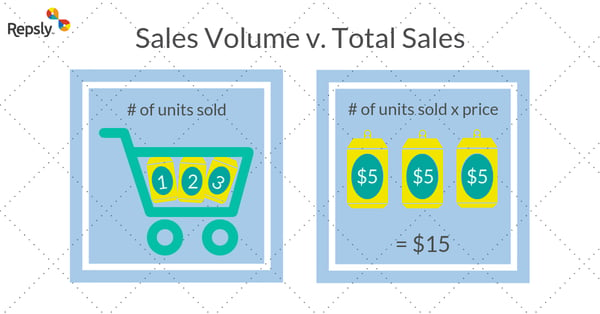Tracking business metrics can show not only where your business has been, but where it should go in the future. For data-driven brands, business metrics can be divided into distinct three types of retail execution data: observational data, activity data, and sales data. Under the category of sales data is where we find sales volume, an important metric that is an indicator of company health and one of the first things investors will look at when evaluating your business.
Sales volume is the number of units that are sold in a given time period. This is not to be confused with total sales, which are usually quantified as a monetary value. Sales volume is measured differently:
Let’s say a cosmetics brand sells 500 units of mascara in Q1. Their sales volume is 500. If the mascara was priced at $10 a unit, their total sales will be $5,000 for Q1. Businesses can vary on how they choose to measure their sales volume. Some may use individual products as their basis of measurement, while others may consider full cases or orders as their units.

Another important note is the difference between gross and net sales volume. Gross sales volume is just the number of units sold with nothing else factored in. Net sales volume takes into account product returns, giveaways, and other factors that may influence the number of units that were actually purchased by consumers.
Now that we understand what sales volume is, let’s talk about a few of the ways it can empower businesses to make better decisions.
Sales Volume for Field Team Planning
When your business has clear data showing you where your product is selling, you can make better-informed decisions on where to send your field team. Sales volume can be broken down even further to analyze performance in certain retailers, territories, or individual stores. This can help you optimize territory management and routing for your reps, making everyone’s lives easier.
You can also calculate sales volume per rep. If your company sells products at several different pricing tiers, you can use sales volume to distinguish between sales volumes of different reps for different products, which is helpful to factor in when evaluating performance. Sales volume metrics are useful for keeping reps on track of their sales goals while empowering management to more easily recognize top performers.
Sales Volume Variances
Sales volume variance is the difference between projected units sold and actual units sold. It is calculated by taking the number of units sold and multiplying by the profit (not price) per unit. Sales volume variance, unlike sales volume, is measured as a dollar amount. For example, let’s say a company projected it would sell 500 units in a given period, but actually sold 700, making a $10 profit per unit. The sales volume variance for this period would be 200 x 10, or $2000. This is a positive variance, whereas if the company had sold less than it projected, we would see a negative variance.
Sales Volume Percentages
Calculating percentages of sales volume can be helpful when identifying trends in the field. Sales volume percentage equals the number of sales from a certain retailer, by a certain rep, or in a certain territory, divided by total sales volume. Going back to what we said earlier, this can be extremely helpful when planning out distribution or managing your field team. Say you want to calculate how much of your sales volume came from a retailer you weren’t previously selling in. If 100 out of your total 500 units sold were scanned at that store, you can calculate the percentage of sales volume for that location is 20%. Depending on where the rest of the 80% were sold, you can prioritize whether or not to go after similar retailers in the future.
Sales Volume Break-Even
Another calculation that can be drawn from sales volume is your company’s break-even sales volume, or how many units you would need to sell to earn a profit of zero. This metric is especially important if your company is seeing a dip in sales, so you know if and when to cut back on spending. You can calculate this number by looking at projected company spend over a given time, and then dividing by the total profit earned per unit. For example, if a company’s projected spend over a given period is $50,000, and they profit $10 a unit, $50,000 / $10 = 5,000, meaning they need to sell at least 5,000 units to break even.
Sales volume is just one of a collection of metrics that are important to business growth. Calculating and tracking your company’s sales volume should feed into a data-driven approach to retail execution, empowering you to identify and execute on the highest impact activities in the field. To learn more about the three types of retail execution data and how your business can benefit from quality data insights, check out this eBook!



.png?width=480&height=252&name=PRESS%20RELEASE-2%20(4).png)

